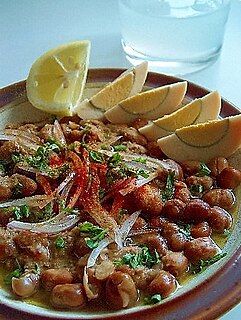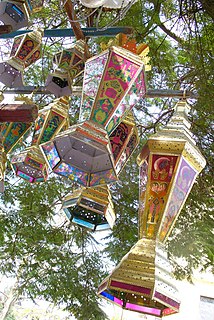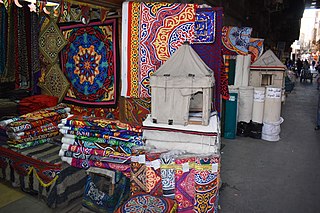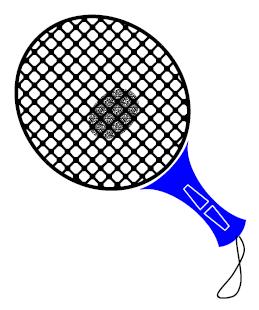 W
WThe culture of Egypt has thousands of years of recorded history. Ancient Egypt was among the earliest civilizations in the world. For millennia, Egypt maintained a strikingly unique, complex and stable culture that influenced later cultures of Europe and the Middle East.
 W
WThe Abaza family, is an Egyptian family of Circassian origin that has had an influence in the late 18th century to modern times. Believed to have a net worth of over 800 million dollars US.
 W
WAlmah or Almeh was the name of a class of courtesans or female entertainers in Egypt, women educated to sing and recite classical poetry and to discourse wittily, connected to the qayna slave singers. They were educated girls of good social standing, trained in dancing, singing and poetry, present at festivals and entertainments, and hired as mourners at funerals.
The Badlah or Badlet Ra'as is a traditional Egyptian folklore costume mostly worn by women, but in some Egyptian weddings men dancers wear it too. The word badlah is an Egyptian Arabic for "suit".
 W
WBaladi can refer to an Egyptian musical style, the folk style of Egyptian bellydance, or the Masmoudi Sogheir rhythm, which is frequently used in baladi music. It is also sometimes spelled in English as 'beledi' or 'baladee'.
 W
WBelly dance; more correctly referred to as Raqs Sharqi is a Middle Eastern dance that has its origins in Egypt since ancient times. It features movements of the hips and torso. It has evolved to take many different forms depending on the country and region, both in costume and dance style; with Egyptian style the most recognized worldwide due to the Egyptian cinema. It is popular worldwide with many schools around the globe now practicing it.
 W
WThe Charioteer Papyrus is a 5th-century fragment of an illustration from an unknown work of literature. It is one of the finest surviving fragments of ancient book illustration. Unlike other surviving illustrated fragments of papyrus, such as the Romance Papyrus and the Heracles Papyrus, which have illustrations that are little more than mere sketches, the Charioteer Papyrus is sensitively drawn and finely colored. It shows portions of six charioteers in the red or green tunics of their factions. It is unlikely that it served as an illustration for the chariot race at the games at the funeral of Patroclus in the Iliad, since the number of charioteers is wrong.
 W
WThe cinema of Egypt refers to the flourishing film industry based in Cairo which is known to be the Hollywood of the MENA region. Since 1976, the capital has held the annual Cairo International Film Festival, which has been accredited by the International Federation of Film Producers Associations. There is also another festival held in Alexandria. Of the more than 4,000 short and feature-length films made in MENA region since 1908, more than three-quarters were Egyptian films. Egyptian films are typically spoken in the Arabic language, especially the Egyptian Arabic dialect.
 W
WThe Eagle of Saladin, in Egypt known as the Egyptian eagle, also known as the Republican Eagle, is a heraldic eagle used as an iconic symbol of Egypt. It is currently also used as part of coat of arms of Egypt, Iraq, Palestine, and of the Southern Transitional Council of South Yemen.
 W
WEgyptian Arabic, locally known as Colloquial Egyptian, or simply Masri (مَصرى), is the spoken vernacular Arabic dialect of Egypt.
 W
WEgyptian cuisine makes heavy use of legumes, vegetables and fruit from Egypt's rich Nile Valley and Delta. It shares similarities with the food of the Eastern Mediterranean region, such as rice-stuffed vegetables and grape leaves, hummus, falafel, shawarma, kebab and kofta. Examples of Egyptian dishes include ful medames, mashed fava beans; kushari, lentils and pasta; and molokhiya, bush okra stew. Pita bread, known locally as eish baladi is a staple of Egyptian cuisine, and cheesemaking in Egypt dates back to the First Dynasty of Egypt, with domty being the most popular type of cheese consumed today.
 W
WEl Sawy Culture Wheel is a cultural center on Gezira Island in the Zamalek district on central Cairo, Egypt. Named after its founder and owner, Abdelmoniem El-Sawy, it is considered one of the most important cultural venues in Egypt and receives more than 20,000 visitors each month.
 W
WFanous or Fanoos, also widely known as Fanous Ramadan, is a folk and traditional lantern used to decorate streets and homes in the month of Ramadan. With their origins in Egypt, they have since spread across the Muslim world and are a common symbol associated with the holy month.
 W
WThe flooding of the Nile has been an important natural cycle in Egypt since ancient times. It is celebrated by Egyptians as an annual holiday for two weeks starting August 15, known as Wafaa El-Nil. It is also celebrated in the Coptic Church by ceremonially throwing a martyr's relic into the river, hence the name, The Martyr's Finger. Ancient Egyptians believed that the Nile flooded every year because of Isis's tears of sorrow for her dead husband, Osiris.
 W
WThe Ghawazi is a local practice describing female dancers who dance inreturn of money, meanwhile the men version of the practice is described as "khawal". They first started as few Egyptian Gypsies who refused to dance for free unlike the common habit among all Egypt, then the idea got extensively practiced and got developed among rural Egyptians or Fellahin, who also developed a more rural and traditional style accompanied by Rural Egyptian songs and colorful dresses of the Fellahin and became a theme of Rural Egypt. Over the years, Upper Egyptians (Sa'idis) mastered and then developed a different style of traditional Saidi dancing that's accompanied by Egyptian mizmar flute and Qena and Assuit's traditional female clothing of Telli (Egyptian Arabic: تلي)) , a super silky type of local fabric. That Upper Egyptian style is the most famous, where the dancer is accompanied by a traditional Upper Egyptian Mizmar and a singer singing and narrating folk-songs in "Saidi Arabic" about local hereos and popular love stories in towns.
 W
WThe khawal was a traditional native Egyptian male dancer cross-dressed in feminine attire and was popular up until the late eighteenth and early nineteenth centuries.
 W
WKhayamiya is a type of decorative appliqué textile historically used to decorate tents across the Middle East. They are now primarily made in Cairo, Egypt, along what is known as the Street of the Tentmakers centered in the Qasaba of Radwan Bey, a historic covered market built in the 17th century. The street is located immediately south of Bab Zuweila, and is located along the historic economic axis of Cairo.
 W
WKoshary, also kushari and koshari, is Egypt's national dish and a widely popular street food. An Egyptian dish that originated during the mid-19th century, the dish combines Italian, Indian and Middle Eastern culinary elements. Koshary is made of rice, macaroni, and lentils mixed together, topped with a spiced tomato sauce and garlic vinegar and garnished with chickpeas and crispy fried onions. It is often served with sprinklings of garlic juice; garlic vinegar and hot sauce are optional.
 W
WEgyptians speak a continuum of dialects. The predominant dialect in Egypt is Egyptian Colloquial Arabic or Masri/Masry, which is the vernacular language. Literary Arabic is the official language and the most widely written; additionally, it is the liturgical language of Islam, the majority religion and state religion of Egypt. The Coptic language is used primarily by Egyptian Copts and it is the liturgical language of Coptic Christianity.
 W
WThe Ministry of Culture of Egypt is a ministry responsible for maintaining and promoting the culture of Egypt. The current minister is Ines Abdel-Dayem, former chairperson of the Cairo Opera and one of six women in the Egyptian Cabinet.
 W
WMusic has been an integral part of Egyptian culture since antiquity in Egypt. Egyptian music had a significant impact on the development of ancient Greek music, and via the Greeks it was important to early European music well into the Middle Ages. Due to the thousands of years long dominance of Egypt over its neighbors, Egyptian culture, including music and musical instruments, was very influential in the surrounding regions; for instance, the instruments claimed in the Bible to have been played by the ancient Hebrews are all Egyptian instruments as established by Egyptian archaeology. Egyptian modern music is considered as a main core of Middle Eastern and Oriental music as it has a huge influence on the region due to the popularity and huge influence of Egyptian cinema and music industries, owing to the political influence Egypt has on its neighboring countries, as well as Egypt producing the most accomplished musicians and composers in the region, specially in the 20th century, a lot of them are of international stature. The tonal structure music in the East is defined by the maqamat, loosely similar to the Western modes, while the rhythm in the East is governed by the iqa'at, standard rhythmic modes formed by combinations of accented and unaccented beats and rests.
 W
WPublic holidays are celebrated by the entire population of Egypt. Holidays in Egypt have many classifications. Some holidays are religious and others are secular, while some can be fixed holidays on the calendar while others are movable. There are four Islamic holidays and two Christian holidays. The national day of Egypt is celebrated on July, 23 which coincides with the annual celebration of the Egyptian revolution of 1952 when the modern republic of Egypt was declared, ending the period of the Kingdom of Egypt.
 W
WThe Scarab ring is a style of finger ring featuring a small sculpture of a scarab as the bezel that was popular in the Egyptian Middle Kingdom and later. They generally incorporated an inscription on the base of the scarab but not always.
 W
WSeega is an abstract strategy game that originated in Egypt. It can be played on boards with cells in a 5x5, 7x7 or 9x9 disposition. Other names include Seejeh, Siga and Sidjah.
 W
WSnake charming is the practice of appearing to hypnotize a snake by playing and waving around an instrument called a pungi. A typical performance may also include handling the snakes or performing other seemingly dangerous acts, as well as other street performance staples, like juggling and sleight of hand. The practice was historically the profession of some tribesmen in India but this is no longer the case. Snake-charmer performances still happen in other Asian nations such as Pakistan. Bangladesh, Sri Lanka and south-east Asian nations like Thailand and Malaysia are also home to performers, as are the North African countries of Egypt, Morocco and Tunisia.
 W
WSpeed-Ball is a racquet sport invented in Egypt in 1961 by Mohamed Lotfy for the training of beginner tennis players. Today it is a sport in its own right, enjoying popularity not only in Egypt but in other countries. Several of these countries make up the International Federation of Speed-Ball (FISB).
 W
WThe Supreme Council of Antiquities (SCA) was a department of the Egyptian Ministry of Culture from 1994 to 2011. It was the government body responsible for the conservation, protection and regulation of all antiquities and archaeological excavations in Egypt, and was a reorganization of the Egyptian Antiquities Organisation, under Presidential Decree No. 82 of Hosni Mubarak.
 W
WTahtib is the term for a traditional stick-fighting martial art originally named fan a'nazaha wa-tahtib. The original martial version of tahtib later evolved into an Egyptian folk dance with a wooden stick. It is commonly described in English as a "stick dance", "cane dance", "stick-dancing game", or as ritual mock combat accompanied by music. Nowadays, the word tahtib encompasses both martial practice and performance art. It is mainly practiced today in Upper Egypt. Tahtib is regularly performed for tourists in Luxor and Aswan.
 W
WIn Lebanese culture, as well as that of arab culture, the zaffa, or wedding march, is a musical procession of bendir drums, bagpipes, horns, belly dancers and men carrying flaming swords. This is an ancient arab tradition that predates Islam. When the procession reaches its destination, usually the house of the bridegroom, there is usually a party, more loud noises, and then dinner.